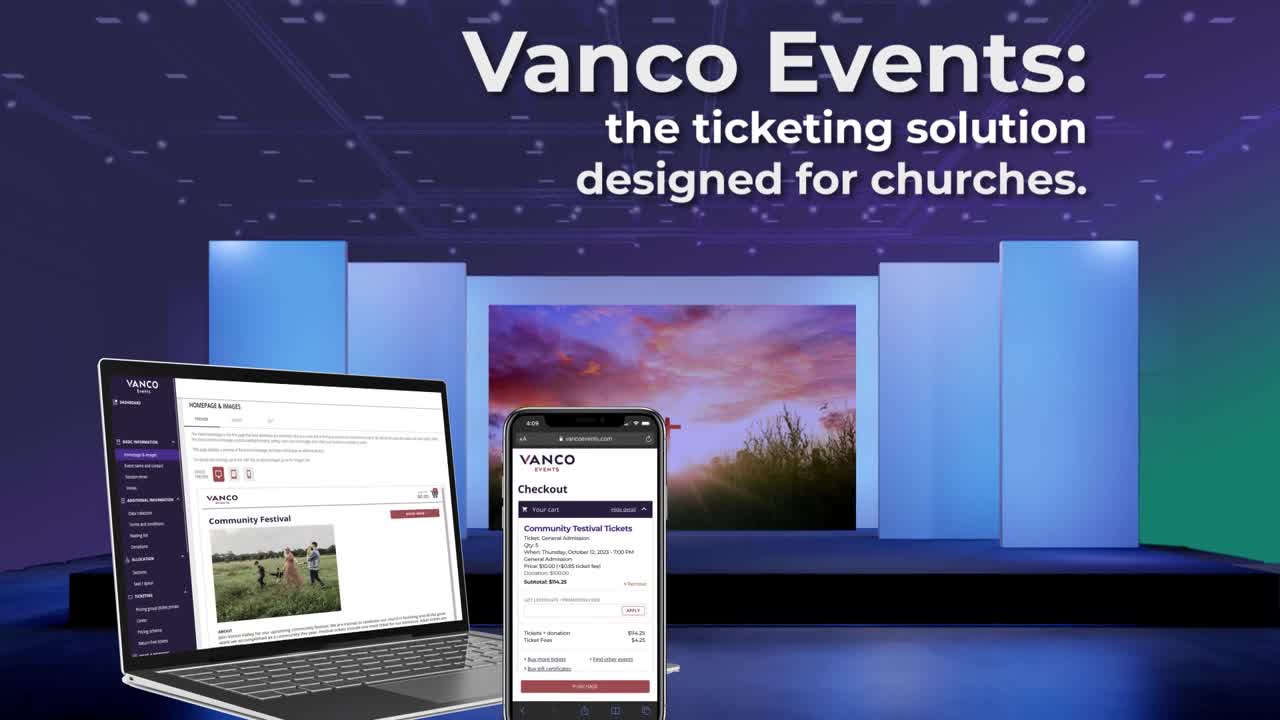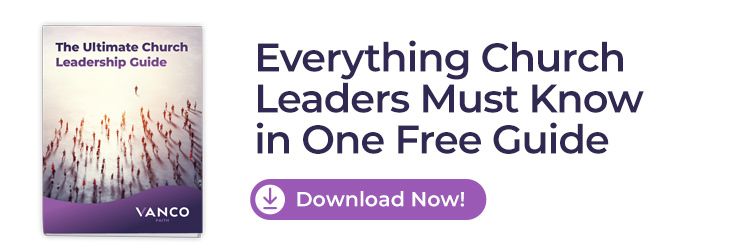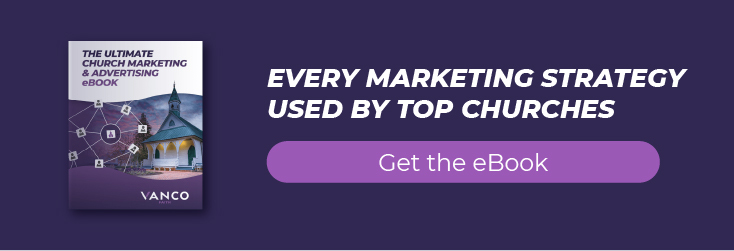
Developing a church strategic plan can take place at any point in a ministry. A pastor starting a church has the same challenges as someone taking over an existing church or restructuring their current ministry.
With about 380,000 churches in the U.S., leaders recognize members have options. Strategic planning for churches has the potential to reignite an organization. It also can become a stressful situation if not done right.
Learn more about how to develop your church's strategic blueprint. Read our guide on creating a church plan.
Table of Contents
- When Should Leadership Create a Church Strategic Plan?
- Craft a Perfect Church Strategic Plan in 10 Key Steps
- 1. Pull Together a Planning Team
- 2. Assess Your Current Situation
- 3. Determine Your Desired Outcome
- 4. Write out a Business Plan
- 5. Create a Vision Statement
- 6. Define the Current Role of the Church
- 7. Outline a Budget
- 8. Define and Expand Stewardship Efforts
- 9. Set Criteria for Leadership Roles
- 10. Layout Policies and Procedures
- Bonus Tips: Branding and Marketing
When Should Leadership Create a Church Strategic Plan?
There's no time like the present to create a church strategic plan. The timing will dictate the urgency and implementation. As the pastor or leader of a religious organization, you first need to have a clear understanding of how you want the ministry to function.
If the leader isn't clear on their intentions, it's a recipe for disaster, and friction can quickly set in.
New Pastor
A new pastor starting a church should create a strategic ministry plan before opening the church doors. Start-up is the most crucial time for the leader. Every business owner will tell you that failing to plan is a plan for failure.
There are many things to consider when starting a church. You'll need to answer the following questions.
- Who is your intended audience?
- What denomination will you serve under?
- When do you plan to open?
- Where do you plan to locate the church?
- Why will people want to join?
Without the answers to the five Ws, you will have a misguided strategic plan and are sure to experience pastoral care challenges.
Incoming Pastor
It’s common for a pastor to inherit a church. This means there’s an existing church, and a pastor has resigned, retired, passed away or been removed from the leadership role.
An incoming pastor will have many challenges. It doesn’t matter if they served in a leadership capacity in the church. Senior pastors are often beloved by the congregation. When their seat becomes vacant, it’s difficult for someone to come in with a new vision. Members will want the church to operate the same.
Many new churches have formed due to a split in leadership following a disagreement in church management. Regardless of how you earned the title of head pastor, a strategic leadership plan is needed.
Current Pastor
As an existing pastor, you must have a pulse for your church at all times. This includes your administrative staff, leadership and membership. Pastors wear many titles, and it's easy to become overwhelmed.
Having a strong support system is essential. When it's time to reassess how the church is doing, hard decisions come into play.
Ongoing strategic planning for churches and ministries is a must. It doesn't mean each year you overall the church operations. Instead, you understand what is working and what isn't. What is trending in ministry, and what members are no longer responding to?
This article will address a church strategy plan for existing churches. However, the information is also valuable for a new ministry as the same rules will apply now and in the future.
Craft a Perfect Church Strategic Plan in 10 Key Steps
Eager to unlock your church's full potential and steer it toward a path of success with unshakeable confidence? If so, let us guide you through crafting an impeccable strategic plan for your church in 10 simple steps.
After reading these steps, you'll be able to convert challenges into opportunities. You'll be able to illuminate your path forward and set your church on the course to success.
Are you prepared to redefine your church's future? Let's dive in!
1. Pull Together a Planning Team
The first step for creating a church strategic plan is to assemble a team. The team will include the following:
- someone from administration.
- individuals from your leadership team.
- ministry leaders.
- business people from within the congregation.
- business people from the community.
- someone with project management experience.
- other community partners.
Create a list of qualifications for team members. Ensure the people you chose have diverse backgrounds and reflect the demographics of your congregation.
Establish rules of order to control the climate of meetings. Set a schedule for meetings and a timeframe to conclude the project.
A person starting a church may find this process runs smoother than someone coming into an established ministry.
2. Assess Your Current Situation
A church strategic plan requires transparency and an open mind. Having the courage to pull in the reigns and go in a different direction takes courage and shows you are a true leader.
Before meeting with your team, make a list of the things you see and what are the causes for concern. List what is working, what is stagnant, and what needs revamping.
Meet with the administrative staff to get their thoughts. Let them know your ideas for strategic planning for the church and ministries. If you have engaged and supportive staff members, their input will mean a lot in the implementation stages.
Conduct a Church Survey
Conducting a church survey on your own or employing a third-party to administer it is a great way to get a pulse for how the church operates, bringing extra clarity to the issues and challenges facing your ministry. Your members will access the confidential survey from an online portal outside the church.
The administrator of the survey will ask questions based on the interview they conduct with you. There are sections for members, ministry volunteers and leaders and the administrative staff. Survey questions can also focus on the church demographics to help drill down on any generational, race or gender divides.
Once the church's strategic survey is completed, you'll receive a comprehensive report and tools to help guide your strategic plan. There are also recommendations on addressing the congregation with the results and next steps to grow a better ministry.
Conduct a SWOT Analysis
When it comes to assessing your church's situation, one of the most powerful tools at your disposal is a SWOT analysis.
SWOT stands for Strengths, Weaknesses, Opportunities and Threats. This framework provides a clear, concise overview of your church's current position and its standing in the face of future challenges and prospects.
Strengths and weaknesses are internal factors within your church. These could include resources, skills or the experiences of your church members. Opportunities and threats, however, are external factors. These might encompass changes in your community, shifts in societal attitudes or even global events.
Does this sound complex? Fear not! Let's break it down:
Strengths: In what areas does your church excel? What unique resources can you leverage? How do others perceive your strengths?
Weaknesses: Where can your church improve? What should you avoid? How might people in your community perceive your weaknesses?
Opportunities: What opportunities can your church seize? Which trends could you capitalize on? How can you turn your strengths into opportunities?
Threats: What threats could jeopardize your church? What obstacles do you face? What actions are your competitors taking?
Steps for Your SWOT Analysis
Follow these steps to start your SWOT analysis:
-
Begin by gathering a diverse group from your church. Include church leaders, volunteers and members of your congregation. The goal is to gain a wide range of perspectives.
-
Brainstorm and list all potential strengths, weaknesses, opportunities and threats. Remember, no contribution is too small!
-
Identify the most significant points in each category. These will form the basis of your strategic decisions moving forward.
-
Analyze and strategize. How can you maximize your strengths and opportunities? How can you minimize your weaknesses and threats?
Voila! After following these four steps, you'll have a clearer understanding of your church's current position and how to strategize for the future.
3. Determine Your Desired Outcome
Now that you have laid out the church’s current status, it’s time to start thinking about the desired outcomes. Examples of outcomes include:
- Growing church membership.
- Changing the culture of the church.
- Building a diverse and global audience.
- Creating satellite churches.
- Opening a social services arm of the church
- Being more involved in the community.
- Providing more opportunities for members to serve.
- Fulfilling personal goals to bring more attention to the ministry.
- Increasing stewardship and giving.
Being intentional about the direction you want to take the church doesn't mean the process will become easier. However, it does make the goals clear and helps pave the path to success.
Use SMART Goals
What if you could set your church on a course that not only meets but surpasses expectations? What if you had a roadmap that illuminated every step of your journey? Enter SMART goals. A tried and true method leveraged by successful organizations worldwide, and yes, that includes churches too.
What Are SMART Goals?
SMART is an acronym for Specific, Measurable, Achievable, Relevant, and Time-bound. These five criteria transform lofty, vague aspirations into clear, achievable objectives. Let's break it down:
- Specific: Your goal should be clear and well-defined. Vague or generalized goals are unhelpful because they don't provide sufficient direction.
- Measurable: Include precise amounts, dates, and so on in your goals so you can measure your degree of success.
- Achievable: Make sure it's possible to achieve the goals you set. While you should stretch your abilities, you want to ensure the goal is within your reach.
- Relevant: Your goals must align with your church's mission and vision.
- Time-bound: You need a deadline. When you're working on a deadline, your sense of urgency increases and achievement will come much quicker.
Crafting SMART Goals for Churches
In the context of a church, SMART goals can be used in various areas from increasing membership, enhancing community outreach programs, to improving fundraising efforts. Here are a few examples:
- Specific: Increase our congregation size.
- Measurable: Grow our congregation by 20%.
- Achievable: Grow our congregation by 20% by hosting weekly community events and enhancing our social media outreach.
- Relevant: Growing our congregation aligns with our mission to spread our faith and build a supportive community.
- Time-bound: Achieve this growth within the next year.
Best Practices for Crafting SMART Goals
- Start by brainstorming what you want to achieve. Then, refine your list so each goal is specific, measurable, achievable, relevant, and time-bound.
- Ensure all stakeholders are involved in the process. This encourages buy-in, shared responsibility, and has the added benefit of including diverse perspectives.
- Finally, remember to review your goals periodically. This helps your church stay on course and allows you to make adjustments as needed.
4. Write Out a Business Plan
Churches need a business plan. Often, church management turns away from a business structure because they don't want to confuse business with their mission. Unfortunately, this is the wrong way to look at planning and structure.
The reality is, the senior pastor is the CEO, the associate pastors are VPs, and ministry leaders are your departmental managers. You might have a secretary, volunteers and other roles who make up your customer service team.
Planning for all these roles as the church grows is easily managed when you have foreseen the church's future.
What Does the Business Plan Include?
- Mission statement - a short statement that addresses the focus and what the church stands for.
- Executive summary - a summary of what the church will offer and why it's beneficial to your intended audience.
- Market research - determine if there's a need for your church and how it will compare to the competition. Invest in studies to see how and what churches similar to yours are doing.
- Church marketing plan - what church marketing strategies and tools you'll need to attract people to the church.
- Management structure - what will it look like. Who is paid and who isn't.
- Day-to-day operations - what are the church's business hours? When are services? How do ministries meet?
- Finances - how will you fund the church? How will tithes and offerings get distributed, and how will capital improvement projects get funded? How to build banking relationships.
Keep in mind, the business plan is separate from a church strategic plan. The business plan should have been a part of the church's original start-up. It's a document you can look back on and revise at five-year increments.
5. Create a Vision Statement
Popular in protestant churches are vision and mission statements. This is different from the mission statement in the business plan.
The church's vision and mission is a call to action for the congregation. It's an open statement that becomes a part of the church brand. The statement appears on the church website, marketing materials and something members know by memory.
In some churches, members recite the statement every Sunday. It's a ritual similar to the Pledge of Allegiance. Reciting the statement each week reinforces the vision and goals of the church’s overall plan and vision for the future.
6. Define the Current Role of the Church
For your strategy plan, define the role of the church in current times. On the surface, people understand the church is there to further the mission of Jesus through discipleship. But what does that look like now?
It's no secret that the church is steadily evolving. Churches are loosening some of their stringent rules and becoming more flexible on traditional practices.
As conversations ramp up regarding secularism entering the church, you'll need a strategic plan to address these concerns. Things to look at are:
- Theology
- Dress codes
- Music
- New ministries
Changes in church culture are huge. As older members are unable to serve or pass away, younger influences will take hold.
7. Outline a Budget
A ministry's strategic plan will have a section for a budget. The budget is a detailed outline of categories that need funding and resources for getting the money that’s needed.
Ministries have options for accounting software to help manage church finances and stay on track. It’s important to understand how money is coming in and going out. Equally important is to become intentional about spending.
There are traditional and alternative revenue sources churches use. Not all of them work for every congregation or have the same results.
Outline in your strategic plan which options you'll use along with financial projections. Alongside traditional tithes and offerings, the church relies on these fundraising sources.
- Annual pledges of support
- Bake sales
- Events
- Fundraisers
- Grants
- Memorial donations
- Special giving opportunities
Before starting a new church, the pastor and leadership need to have enough cash on hand to carry the church for at least two years.
8. Define and Expand Stewardship Efforts
Imagine navigating a ship without a compass. Challenging, isn’t it? This is what running a church without a stewardship plan is like. A strong church stewardship plan acts as your guiding compass, providing clear direction and purpose for your church's resources. But why is it so critical?
-
Resource Management: A stewardship plan ensures the effective management of your church's resources. It helps you prioritize and allocate resources efficiently, ensuring they are used to their full potential.
-
Financial Stability: With a well-crafted stewardship plan, your church can achieve financial stability. It sets forth strategies for fundraising, budgeting, and expenditure control, thereby preventing financial pitfalls.
-
Vision Alignment: A stewardship plan aligns all financial decisions with the church's vision and mission. This alignment not only propels your church towards its goals but also fosters unity among members.
-
Transparency: Lastly, a stewardship plan promotes transparency. It provides a clear roadmap of where resources are going, instilling trust and encouraging more generosity among members.
The Impact of a Strong Stewardship Plan on Your Church's Strategic Plan
The stewardship plan fuels your strategic plan, driving your church toward its objectives.
It sets the stage for achieving your strategic goals, whether it's growing your congregation, enhancing your outreach programs, or improving your ministry's impact. It provides the resources needed to turn your strategic vision into a reality.
In essence, a strong church stewardship plan is not just an option; it's a necessity for your church's strategic plan. It’s the key to unlocking your church's full potential and steering it toward a path of success.
I you're looking for help crafting a strong stewardship strategy, we built this free guide to help.
Getting the Right Tools to Boost Church Stewardship
Imagine this: Your congregation is brimming with goodwill and generosity, but the traditional methods of tithing limit their expression. In the world of checks and cash, the spirit of giving becomes constrained by logistics. Sounds familiar? Well, it's time for a change.
Let's take a virtual tour of seven key technologies that will not only grow your tithes and offerings but also enhance your congregation's connection to your church's mission.
-
Online Giving Pages: What if your congregation could donate anytime, anywhere, with just a few clicks? Online giving pages make this possible, transforming the way your church receives contributions. Watch this video to see how online giving pages work.
-
Automatic Giving: What if your congregation could set up recurring donations, ensuring a steady stream of support for your church? Automatic giving makes this a reality. Check out this free guide to learn more about boosting recurring gifts.
-
Mobile Donations: What if your congregation could donate with the same ease as sending a text message? Mobile giving apps make this possible, turning smartphones into a conduit for generosity. This video covers just a few of those features.

4. Text-to-Give Software: What if contributing to your church was as simple as sending a text? Text-to-give software for churches offers a swift, secure method for members to contribute via their smartphones, leading to an uptick in tithes and offerings.

5. In-Livestream Giving: What if your virtual attendees could weave their offerings into their worship seamlessly? In-livestream giving captures fleeting moments of inspiration, making generosity an integral part of the digital worship experience. Watch How In-Livestream Tithes and Offerings Capture Generosity.
6. Mobile Card Readers: What if your congregation could swipe or tap their way to blessings? Mobile card readers allow immediate, hassle-free offerings, fostering a culture of giving, no matter the format.
7. Event Ticketing: What if your community events could supplement tithes and offerings? Church event ticketing provides an avenue for diversified financial stability, while igniting curiosity and drawing new faces into your church's fold.

9. Set Criteria for Leadership Roles
As the church grows, there will be opportunities to select associate pastors and other executive leadership roles. Leadership in ministry has a higher calling than someone in a secular organization.
People placed in these roles are charged with overseeing ministries and volunteers. They need to have integrity and above-average people management skills.
Misconduct by church leadership can significantly impact your church's reputation and standing in the community. It can also lead to legal liability.
Determine how many leadership roles you'll need and under what circumstances additional roles will get added. Also, ask yourself if there are leadership roles that aren't directly related to a specific ministry. For example, deacons, deaconesses, trustees and attorneys.
The criteria will include:
- Who makes selections.
- How long do appointments last.
- Is compensation involved.
- Roles and responsibilities.
A lot of the duties and responsibilities will depend on the size of the congregation.
10. Layout Policies and Procedures
The church will need policies and procedures as it pertains to the operation of the church. In addition, you'll need policies and procedures in the church strategic plan that deals with ministries and the use of church growth tools.
Without having policies in place, you run the risk of people taking ownership of procedures and tailoring them to fit their needs.
New Membership Tools
It's one thing to bring people into your ministry. It's another to shepherd and watch over their spiritual growth.
After extending the invitation to individuals, devise a way to gather demographic information. Will your church offer new membership courses? Decide how and when courses are administered. How many courses are offered, and if they'll be available online? The end goal of new membership courses is to reinforce stewardship and encourage people to join a ministry.
It's a nice gesture to celebrate members that successfully complete new membership programs. One Sunday each month, introduce new members to the congregation and host a meet and greet.
Creating a Ministry
There are basic ministries that every church has. These include men's ministry, women's ministry, youth and young adult ministries. What happens when a member has an idea for a new ministry?
Strategic planning for churches and ministries must be in place to examine the need of the ministry vs. the culture of the church.
Ideas for new ministries must align with the church’s core values and have a spiritual and Biblical foundation.
Joining a Ministry
Not everyone wants to join a ministry. For those excited about giving service to kingdom building, you'll need guidelines. Some churches require membership and the completion of membership classes before joining a ministry.
Other policies can include the number of ministries a person can serve on at once. How long does a person have to volunteer in a ministry before assuming a leadership role? In addition, guidelines are needed to cover terms of leadership and successor training.
Street Teams
A street team is a new-age term used to reference evangelism duties. Since the members of these teams are going into the community as representatives of the church, you may become exposed to legal liability.
Consult with your insurance representative to discuss the church's exposure in the event someone is injured. You'll want to have policies on passing out materials, taking pictures, recording footage and supervision for minors.
Community Outreach
Community outreach can include many activities. The activities will need individual listings. For the most part, these activities will include partnerships with other churches, non-profits and civic organizations.
Anytime your members and leadership have an opportunity to engage with people in the neighborhood, it shows you are committed to the community. In times like the COVID-19 pandemic, the church has many ways to perform outreach.
When a strategic plan is in place, it becomes easier to mobilize and reach those in need.
Bonus Tips: Branding and Marketing
Strategic planning for churches and ministries isn't complete without a plan for branding and marketing. With today's church technology, apps, and digital content, churches can easily strategize how to get in front of their target audience.
Your church brand is how people will identify and connect with your ministry. Larger churches have put a lot into branding. Everything from logos to catchphrases to color schemes are created with care.
To access a comprehensive guide on enhancing, sustaining, and advancing your brand, consider our succinct course. It offers free resources to maximize your initiatives and takes you through a tested process specifically designed for churches.
The ultimate goal in marketing is to grow your platform using name recognition. Here are must-haves for your strategic plan.
Church Website
The website isn't only your digital calling card. It's also a hub for church applications. Your church website needs a clean look. Stay away from being gimmicky. Avoid distractions like music and a lot of flash media. Include the following:
- Events banner on the homepage.
- Service times and contact information.
- Church history.
- Pastor bio.
- Ministry pages.
- A church donation page.
- A church blog.
- Links to the social media platforms.
- Live streaming software for services.
Become intentional about sharing the link to your website to drive traffic.
Online Directory
An online directory, when done right, can become a personalized social platform for the church. Basic directories only focus on capturing member contact information.
A strategic plan for the church can involve replacing the church directory currently on an Excel spreadsheet maintained by the church secretary. Instead, it becomes an online hub for ministries to communicate with volunteers and members to communicate with each other.
There are free church apps that include a directory and other helpful tools for your ministry. You can get one for your church by clicking here.
Social Media
Social media has grown tremendously, and over 69% of adults are on Facebook alone. Churches cannot ignore the fact their members are part of these online communities.
Your church strategy plan will outline which social sites can best represent the church. What tools you can use to engage congregants and attract more people. Social media strategies the church can use to build its online presence go beyond posting images and video. For more on social media strategies for churches, you can access our full guide for free.
E-marketing
Email marketing has been around for a while. Some people may believe it's outdated and ineffective. The truth is if you have a strategy for the content you're sending out, chances are your open rate and engagement with improve.
With the implementation of a mobile app, you can notify email subscribers when a new email campaign goes out. Some services allow users to open the email within the app or a browser. This is beneficial because they don’t have to log into their email to see the content.
Live Streaming
Our last recommendation for a church strategic plan is also the biggest. If your church isn't taking advantage of live streaming, you are behind and need to play catch-up.
Regardless of church size, to remain relevant in today's society and plan for growth, you need to get your sermons outside of the physical church. To do this, you have to invest in streaming.
Platforms like YouTube and Facebook offer free streaming. Try Vanco's free, comprehensive Facebook Live Streaming Guide for Churches to master streaming on the platform. It will show you best practices, the equipment you need, how to set up a stream and much more.
Get Everything You Need to Know About Church Growth
Download our free eBook to learn everything you need to know about church growth. By following the guidelines and tested strategies outlined in our eBook, you’ll have the framework needed to give your church a necessary jolt.













